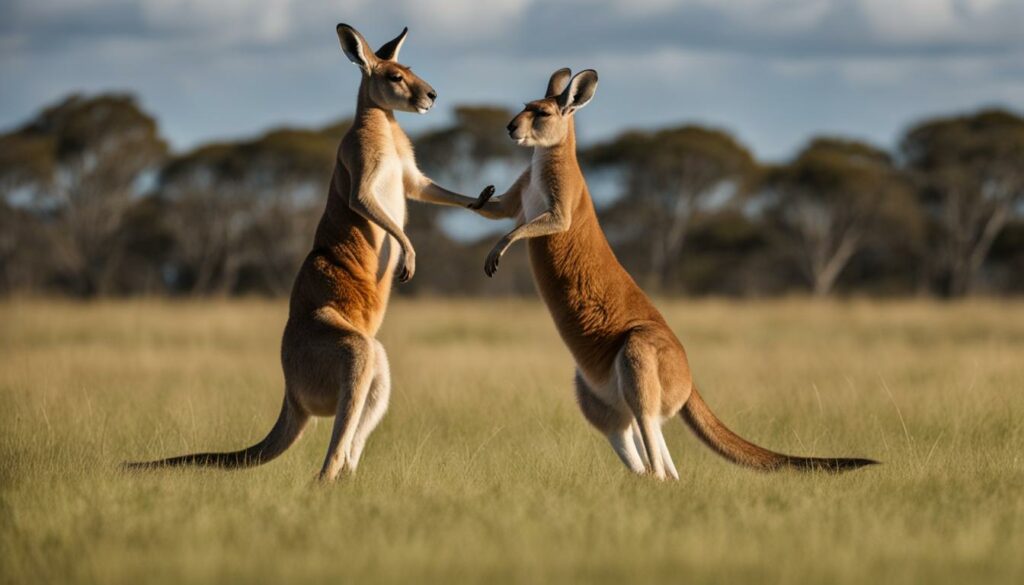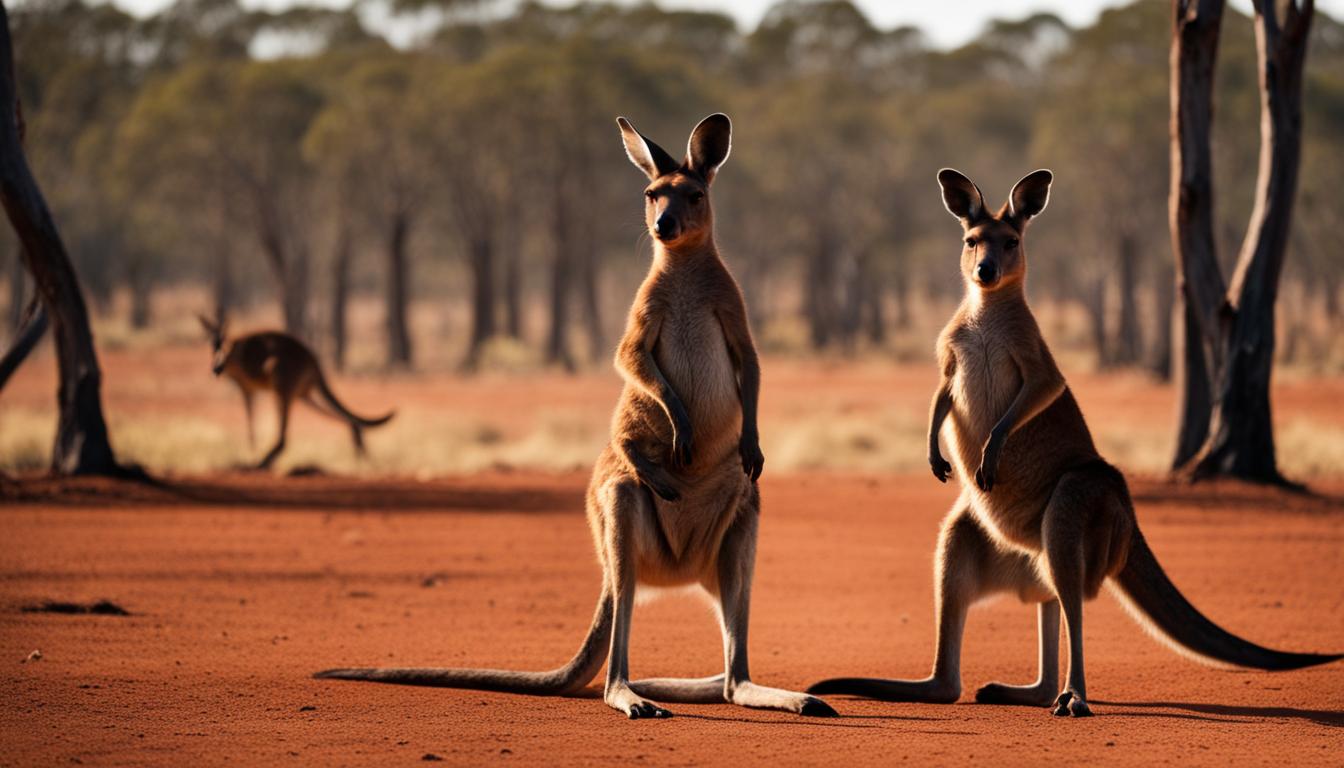Have you ever wondered if kangaroos really engage in boxing? Well, the answer may surprise you! Kangaroos do exhibit a behavior that resembles boxing, especially during mating season. They use their front legs to take swipes at each other’s heads and stomachs, creating a spectacle that has fascinated people for years. If you’re curious about this intriguing behavior, read on to discover some interesting kangaroo boxing facts and find out more about the purpose behind it.
Before we delve into the details, you might be wondering where you can witness kangaroo boxing in action. Look no further than the fascinating kangaroo boxing videos available online. These videos capture the thrilling encounters between male kangaroos and give you a glimpse into this unique behavior.
The History of Kangaroo Boxing
Throughout history, the image of a boxing kangaroo has become synonymous with the fighting spirit of Australia. The roots of kangaroo boxing can be traced back to the 1890s when it first gained recognition as a symbol of Australian identity. Since then, it has been featured in various forms of media, including cartoons and snack food packaging, and has even served as the official symbol of the Royal Australian Air Force during World War II.
One notable example of kangaroo boxing in popular culture is the 1933 film “Matilda,” where a boxing kangaroo named Jacko takes on human opponents in the boxing ring. This film showcased the entertainment value and spectacle associated with kangaroo boxing at the time. The sport gained international prominence in 1983 when the boxing kangaroo became the symbol for the Australian challenge in the America’s Cup, further solidifying its place in Australian culture.
Today, the image of the boxing kangaroo is widely recognized and associated with Australian sports teams and events. It is often seen displayed by Australian spectators at sporting matches, including cricket, tennis, basketball, and football games. The symbol has become ingrained in the fabric of Australian society and continues to represent the country’s spirited nature.
The Evolution of the Boxing Kangaroo Symbol
The popularity of the boxing kangaroo symbol can be attributed to its ability to capture the essence of Australian culture and identity. It embodies traits such as resilience, strength, and a fighting spirit. The image of a kangaroo using its front limbs to “box” resonates with the toughness and determination often associated with Australians.
How do kangaroos fight?
Kangaroos have a unique fighting style that relies heavily on their powerful hind legs and strong tails. When engaging in combat, kangaroos stand upright and use their forepaws to grasp the neck of their opponent. In this high-standing posture, they engage in a wrestling match, pawing each other’s chest, neck, shoulder, and head. This grappling technique allows them to exert control and dominance over their opponent.
One of the most impressive moves in a kangaroo’s fighting repertoire is their ability to balance on their tails while delivering powerful kicks with their hind legs. These kicks can target the opponent’s abdomen and are delivered with great force, capable of inflicting serious injuries. Kangaroos have long, strong hind legs that enable them to generate impressive power in their kicks, making them formidable opponents in a fight.
It is important to note that not all kangaroo fights are aggressive or combative. Play fighting is a common behavior among kangaroos, particularly between mothers and their young joeys. This non-violent activity helps the young kangaroos develop fighting skills that are crucial for their survival in the wild. Through playful sparring, they learn how to grapple, balance, and coordinate their movements, preparing them for potential encounters with predators in the future.
| Fighting Technique | Description |
|---|---|
| Grasping and Wrestling | Kangaroos use their forepaws to grasp the neck of their opponent and engage in a wrestling match, exerting dominance. |
| Balancing and Kicking | Kangaroos can balance on their tails and deliver powerful kicks with their hind legs, targeting their opponent’s abdomen. |
| Play Fighting | Kangaroos engage in non-violent play fighting to develop fighting skills for survival in the wild. |
The Purpose of Kangaroo Boxing
Kangaroo boxing serves several purposes in the animal kingdom. Firstly, it is a way for male kangaroos to establish dominance and determine their position in the hierarchy. Just like human athletes, kangaroo boxers engage in competitive bouts to prove their strength and claim the title of alpha male. The winner of a boxing match may have privileged access to females for mating, ensuring the continuation of their genetic lineage.
Additionally, kangaroo boxing can also be a form of defense against predators. Kangaroos have powerful hind legs that they can use to deliver swift and forceful kicks. This ability not only helps them ward off potential threats but also ensures the safety of their young. By engaging in boxing behavior, kangaroos demonstrate their physical prowess and send a clear message to predators to stay away.
“Through their boxing matches, kangaroos establish a social order within their communities. The winner becomes the dominant male, whereas the loser must submit to the victor’s authority.”
It is important to note that kangaroo boxing is a natural behavior and not a regulated sport. Unlike human boxing, there are no specific rules or champions in kangaroo boxing. It is a purely instinctual behavior driven by the need to reproduce and survive in the wild. While fights can be intense, they are typically ritualized and rarely result in serious injury or death. Kangaroo boxers rely on their agility, strength, and well-honed instincts to navigate these encounters.

The dangers of kangaroo boxing
Kangaroo boxing can be an inherently dangerous activity, posing risks for both the kangaroos themselves and any humans who may come in contact with them. It is crucial to understand the potential hazards involved and take appropriate precautions to ensure safety.
For humans, the most significant danger lies in the powerful kicks of the kangaroos. These kicks can cause serious injuries, including broken bones and internal damage. It is essential to maintain a safe distance and avoid provoking or antagonizing the kangaroos that are engaged in boxing behavior. Using protective gear, such as kangaroo boxing gloves, can offer some level of protection but should only be used by trained professionals in controlled environments.
Additionally, kangaroos have sharp claws that they can use to inflict harm, particularly targeting the eyes of their opponents. This can result in severe injuries and potential blindness. Interactions with kangaroos should always be approached with caution, and it is advisable to seek guidance from wildlife experts or trained professionals in dealing with these situations.
“Kangaroo boxing can be dangerous for both humans and the kangaroos involved, and it is important to treat these animals with respect and prioritize their well-being,” says Dr. Emma Johnson, a wildlife biologist specializing in Australian marsupials.
The importance of kangaroo boxing rules
- Regulations and guidelines for kangaroo boxing do not exist, as it is primarily a natural behavior and not a regulated sport.
- However, establishing specific rules and guidelines could help mitigate the risks involved and ensure the welfare of both the kangaroos and those who encounter them.
- These rules would need to consider factors such as training and certification of individuals involved, proper use of protective gear, and adherence to ethical and humane practices.
By implementing kangaroo boxing rules, we can promote responsible interactions with these fascinating creatures while prioritizing their welfare and minimizing the potential for harm.
| Common Dangers | Precautions |
|---|---|
| Potential for serious injuries from kicks | Maintain a safe distance and avoid provoking kangaroos |
| Risks of claw injuries, especially to the eyes | Seek guidance from wildlife experts and trained professionals |
| Unregulated nature of kangaroo boxing | Implement specific rules and guidelines to ensure safety and welfare |
Table: Common dangers of kangaroo boxing and the corresponding precautions that should be taken to mitigate these risks.
Kangaroo boxing in popular culture
The image of the boxing kangaroo has become a popular symbol in Australian pop culture. It is often displayed by Australian spectators at sporting events, including cricket, tennis, basketball, and football matches. The boxing kangaroo is also associated with the Australian national rugby league team, known as the Kangaroos. The symbol has been used in films, cartoons, and even on flags.
“The boxing kangaroo is a symbol that represents the fierce spirit and determination of Australians. It embodies our fighting mentality and our love for sports,” says Mark Thompson, a sports commentator.
One notable example of kangaroo boxing in popular culture is the 1983 America’s Cup, a prestigious sailing competition. The Australian team, representing the Royal Perth Yacht Club, used the boxing kangaroo as their symbol and mascot. The image was emblazoned on their sails and became synonymous with their campaign. The boxing kangaroo provided a sense of national pride and rallied support for the Australian team.
| Event | Description |
|---|---|
| Cricket matches | Australian spectators often wave flags with a boxing kangaroo image to support their team. |
| Rugby league matches | The Australian national rugby league team, also known as the Kangaroos, features the boxing kangaroo on their jerseys. |
| Film and television | Several films and cartoons have featured boxing kangaroos as characters, showcasing their fighting abilities and Australian heritage. |
With the advent of the internet and social media, there has been an increase in the availability of kangaroo boxing videos. These videos provide a unique opportunity for people around the world to witness this behavior firsthand. They showcase the agility, strength, and unique fighting style of kangaroos, further fueling the fascination with this intriguing behavior. However, it is important to remember that kangaroo boxing videos should be appreciated as a natural behavior and not as a form of entertainment or exploitation.
Conclusion
Kangaroo boxing is a captivating behavior displayed by male kangaroos during mating season. This ritualized form of fighting resembles boxing, with males using their front legs to swipe at each other’s heads and stomachs. It is a way for these magnificent creatures to establish dominance and determine which male gets the privilege to mate with a particular female.
While kangaroo boxing can be dangerous, it is a natural behavior that should be respected. Kangaroos have powerful kicks and claws that can cause serious injuries. It is crucial for humans to exercise caution and maintain a safe distance when observing kangaroo boxing behavior in the wild.
The image of the boxing kangaroo has become an iconic symbol of Australian culture, representing the country’s fighting spirit. It is displayed proudly by Australian spectators at sporting events and is associated with national sports teams. Kangaroo boxing has a rich history, with its roots dating back to the 1890s. However, it is important to note that kangaroo boxing is not a regulated sport with specific rules or champions. It is primarily a natural behavior that serves various purposes within kangaroo society.
In conclusion, kangaroo boxing is a fascinating display of strength and dominance within the kangaroo community. It is a behavior that has captivated people around the world and has become an integral part of Australian culture. Understanding the facts and history behind kangaroo boxing allows us to appreciate these incredible creatures even more.
Does the boxing behavior of kangaroos play a role in their adaptation to their environment?
Yes, the boxing behavior of kangaroos is essential for their kangaroos’ environmental adaptability. It helps them establish dominance, maintain territories, and protect themselves from predators. This unique adaptation allows them to survive and thrive in the Australian outback where resources are scarce and competition is high.
FAQ
Do kangaroos really box, and what is the purpose of this behavior?
Yes, kangaroos engage in a behavior that resembles boxing, particularly during mating season. The purpose of this behavior is for males to establish dominance and determine their position in the hierarchy, as well as to compete for mating opportunities with females.
What is the history of kangaroo boxing?
The image of a boxing kangaroo has been a symbol of the Australian fighting spirit since the 1890s. It gained international prominence in 1983 when it became the symbol for the Australian challenge in the America’s Cup. Since then, it has been associated with Australian sports teams and events.
How do kangaroos fight?
Kangaroos primarily fight by using their strong tails and powerful hind legs. They stand upright and grasp the neck of their opponent with their forepaws. They may also balance on their tails and kick their opponent’s abdomen with their hind legs. Play fighting is a non-violent activity that helps young kangaroos develop fighting skills.
What is the purpose of kangaroo boxing?
Kangaroo boxing serves several purposes. It is a way for males to establish dominance and determine their position in the hierarchy, as well as to compete for mating opportunities with females. It can also be a form of defense against predators, as kangaroos can use their powerful hind legs to deliver kicks.
Are kangaroo boxing matches regulated like a sport?
No, kangaroo boxing is a natural behavior and not a regulated sport. There are no specific rules or champions in kangaroo boxing. It is primarily a ritualized behavior for establishing dominance and competing for mates.
Are kangaroo boxing matches dangerous?
Yes, kangaroo boxing can be dangerous for both the kangaroos and humans. Kangaroos have powerful kicks that can cause serious injuries, including broken bones and internal injuries. Humans should exercise caution and maintain a safe distance from kangaroos engaging in boxing behavior.
How is kangaroo boxing represented in popular culture?
The image of the boxing kangaroo has become a popular symbol in Australian pop culture. It is often displayed by Australian spectators at sporting events and is associated with Australian sports teams. There are also numerous videos available online showcasing kangaroo boxing behavior.











